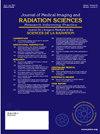利用混合放射技师评论模式改善急诊科的患者治疗效果并降低风险
IF 1.3
Q3 RADIOLOGY, NUCLEAR MEDICINE & MEDICAL IMAGING
Journal of Medical Imaging and Radiation Sciences
Pub Date : 2024-10-01
DOI:10.1016/j.jmir.2024.101538
引用次数: 0
摘要
背景/目的医学影像检查结果的口头交流可能会被误解,而且缺乏透明度。我们在五家医院试行了一种混合模式,利用放射技师的评论和急诊科(ED)的口头通知,在护理点更及时、更安全地传达普通 X 光片的异常情况。多学科指导小组就设计和实施策略提供建议。放射技师的意见从成像控制台传输到急诊室仪表板,并向急诊室医生/转诊团队口头通报危重/紧急病情。放射技师的意见(n=1102)由 69 名放射技师(全天候)发送到五个急诊室(ED),至少持续了三个月。在试点地点收集了阳性预测值 (PPV)、报告周转时间 (TAT) 和有临床意义的病例。放射技师的意见与放射学报告进行比较,并由两名独立审计员分为真阳性 (TP)、假阳性 (FP) 或不确定 (ID)。与急诊室转诊医生和/或现场放射科医生一起调查 FP 和 ID 评论。风险评估由两名独立的放射科医生进行,分为低、中、高和极高四个等级。与急诊室医生和进一步的成像数据确认偶然发现的放射报告差异。威尔逊评分区间确定了置信水平。结果平均PPV为0.96;(0.949 - 0.972;95% CI)。对不正确的意见(42 条)进行了潜在危害分析;(3.9%;95% CI:2.9 - 5.3)。风险评估显示,其中 37 例为低风险,5 例为中度风险,没有高风险。282 名患者从中受益(26.4%;95% CI:23.8 - 29.1%),42 份放射报告存在差异;(3.9%;95% CI:2.9 - 5.3)。四分之一的患者受益于放射技师的意见。3.9%的病例可以减轻风险。无不良结果报告。本文章由计算机程序翻译,如有差异,请以英文原文为准。
Improved patient outcomes and risk mitigation in Emergency Departments using a hybrid Radiographer Comment model
Background/Purpose
Verbal communication of medical imaging findings can be misinterpreted and lacks transparency. A hybrid model using radiographer comments and verbal notification to Emergency Departments (ED) was piloted across five hospitals for the more timely and safe communication of abnormal general x-ray appearances at point of care. Pilot data was evaluated to identify patient benefits and risks.
Methods
A multidisciplinary steering group advised on design and implementation strategies. The radiographer comments were transmitted from imaging consoles to ED dashboards and verbal calls provided to the ED doctor/referring team for critical/urgent conditions.
Radiographer comments (n=1102) were sent to five Emergency Departments (ED) by 69 radiographers (24/7) for a minimum of three months. Positive Predictive Values (PPV), reporting Turn Around Times (TAT) and clinically significant cases were collected at pilot sites. Radiographer comments were compared with radiology reports and classified as True Positive (TP), False Positive (FP) or indeterminate (ID) by two independent auditors. FP and ID comments were investigated with ED referrers and/or site radiologists. Risk assessments were conducted by two independent radiologists using low, moderate, high-very high categories. Radiology report discrepancies found incidentally were confirmed with ED doctors and further imaging data. Wilson Score Intervals determined confidence levels.
Results
The average pooled PPV was 0.96; (0.949 - 0.972; 95% CI). Incorrect comments (42) were analysed for potential harm; (3.9%; 95% CI: 2.9 - 5.3). A risk assessment for these demonstrated 37 low, five moderate and no high-very high-risk cases. 282 patient benefits (26.4 %; 95% CI: 23.8 – 29.1%) and 42 radiology report discrepancies were identified; (3.9%; 95% CI: 2.9 - 5.3).
Conclusions
The model is based on patient advocacy and has the potential to save lives. A quarter of patients benefited from radiographer comments. Risk mitigation was possible in 3.9% of cases. No adverse outcomes were reported.
求助全文
通过发布文献求助,成功后即可免费获取论文全文。
去求助
来源期刊

Journal of Medical Imaging and Radiation Sciences
RADIOLOGY, NUCLEAR MEDICINE & MEDICAL IMAGING-
CiteScore
2.30
自引率
11.10%
发文量
231
审稿时长
53 days
期刊介绍:
Journal of Medical Imaging and Radiation Sciences is the official peer-reviewed journal of the Canadian Association of Medical Radiation Technologists. This journal is published four times a year and is circulated to approximately 11,000 medical radiation technologists, libraries and radiology departments throughout Canada, the United States and overseas. The Journal publishes articles on recent research, new technology and techniques, professional practices, technologists viewpoints as well as relevant book reviews.
 求助内容:
求助内容: 应助结果提醒方式:
应助结果提醒方式:


